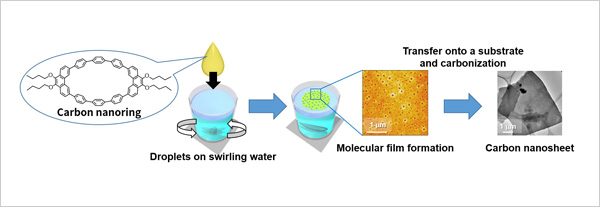Simple 2D Carbon Nanosheet Synthesis in a Beaker Using Carbon Nanorings
—Technique May Enable Easy, Bottom-Up Synthesis of Various Two-Dimensional Materials—
2018.07.06
National Institute for Materials Sciences
Japan Science and Technology Agency
Nagoya University
University of Tokyo
NIMS, Nagoya University and the University of Tokyo jointly developed a simple technique to easily synthesize carbon nanosheets, a material of great importance due to its high electrical conductivity, strong catalytic capabilities and unique electronic properties.
(“Carbon Nanosheets by Morphology-Retained Carbonization of Two-Dimensional Assembled Anisotropic Carbon Nanorings” Taizo Mori, Hiroyuki Tanaka, Amit Dalui, Nobuhiko Mitoma, Kengo Suzuki, Mutsuyoshi Matsumoto, Nikhil Aggarwal, Archita Patnaik, Somobrata Acharya, Lok Kumar Shrestha, Hirotoshi Sakamoto, Kenichiro Itami, Katsuhiko Ariga; Angewandte Chemie International Edition 6 July 2018; doi:10.1002/anie.201803859)
Abstract
- NIMS, Nagoya University and the University of Tokyo jointly developed a simple technique to easily synthesize carbon nanosheets, a material of great importance due to its high electrical conductivity, strong catalytic capabilities and unique electronic properties. They can be easily synthesized by adding carbon nanorings (circular carbon molecules) to the surface of swirling water in a beaker, thereby allowing them to spontaneously transform into a molecular film which is then transferred onto a substrate and burned This technique does not require expensive equipment or advanced technology and may be applicable to the fabrication of catalytic membranes for solar cells, touch panels and fuel cells.
- Carbon nanosheets, including graphene, are two-dimensional carbon materials. Their high electrical conductivity and catalytic capabilities make them appropriate for use in novel electronic materials and catalytic membranes. However, the synthesis of high-quality carbon nanosheets requires a nanoscale-controlled assembly of carbon-rich molecules, necessitating the use of advanced techniques and expensive equipment, and the assembled nanostructures are too fragile to survive the final high-temperature carbonization process.
- The joint research group was able to fabricate porous thin films with a uniform pore size of several tens of nanometers using simple techniques: water is poured into a beaker and swirled and carbon nanorings (i.e., circular carbon molecules) are added to the water and allowed to float on its surface. The beaker is then left to stand to allow the nanorings to transform into a molecular film which is transferred to a substrate. By applying a thermal treatment, the group succeeded in converting the thin film into a carbon nanosheet without damaging its mesoporous structure.
- The technique developed in this research was found to be applicable to the synthesis of carbon nanosheets containing nitrogen, which are presumed to be catalytically active. The method may therefore be applied to the fabrication of a variety of catalysts, including fuel cell catalysts free of expensive platinum.
- This project was carried out by a research team led by Taizo Mori (Special Researcher, Supermolecules Group, NIMS), Katsuhiko Ariga (leader of the Supermolecules Group, NIMS; also Professor, Graduate School of Frontier Sciences, University of Tokyo) and Kenichiro Itami (Professor, Nagoya University).
This study was conducted in conjunction with the Itami molecular nanocarbon project (Research Director: Kenichiro Itami) funded by the Japan Science and Technology Agency (JST)’s Exploratory Research for Advanced Technology (ERATO) program. It was also supported by the Japan Society for the Promotion of Science (JSPS)’s Grant-in-Aid for Scientific Research in Innovative Areas: coordination asymmetry. - This research was published in the online version of Angewandte Chemie International Edition on July 6, 2018, local time.

Figure. Synthesis of carbon nanosheets using carbon nanorings
Related files
- MANA
Contacts
(Regarding this research)
-
Taizo Mori
NIMS Special Researcher,
Supermolecules Group,
Nano-Materials Field,
National Institute for Materials Science
TEL: +81-29-851-3354
E-Mail: MORI.Taizo=nims.go.jp
(Please change "=" to "@") -
Katsuhiko Ariga
Professor, Department of Advanced Materials Science
Graduate School of Frontier Sciences
University of Tokyo
Tel: +81-29-860-4597
E-Mail: ARIGA.Katsuhiko=nims.go.jp -
Kenichiro Itami
Research Director for the JST ERATO-funded Itami molecular nanocarbon project
Director of the Institute of Transformative Bio-Molecules, Nagoya University
Professor, Graduate School of Science, Nagoya University
Tel: +81-52-788-6098
E-Mail: itami=chem.nagoya-u.ac.jp
(Please change "=" to "@")
(For general inquiries)
-
Public Relations Office
National Institute for Materials Science
1-2-1 Sengen, Tsukuba, Ibaraki 305-0047, Japan
Tel: +81-29-859-2026
Fax: +81-29-859-2017
E-Mail: pressrelease=ml.nims.go.jp
(Please change "=" to "@") -
Public Relations Division
Japan Science and Technology Agency
Tel: +81-3-5214-8404
Fax: +81-3-5214-8432
E-Mail: jstkoho=jst.go.jp
(Please change "=" to "@") -
Public Relations Office
General Affairs Division, General Affairs Department
Nagoya University
Tel: +81-52-789-2699
Fax: +81-52-789-2019
E-Mail: kouho=adm.nagoya-u.ac.jp
(Please change "=" to "@") -
General Affairs Section
Graduate School of Frontier Sciences
University of Tokyo
Tel: +81-4-7136-5578
Fax: +81-4-7136-4020
E-Mail: sato.yumiko=mail.u-tokyo.ac.jp
(Please change "=" to "@")
(Regarding JSPS Grant-in-Aid for Scientific Research)
-
Mitsuhiko Shionoya (Professor)
Leader of the Coordination Asymmetry Area under the Japan Society for the Promotion of Science (JSPS)’s Grant-in-Aid for Scientific Research in Innovative Areas
Tel: +81-3-5841-8061 (extension: 28061)
E-Mail: shionoya=chem.s.u-tokyo.ac.jp
(Please change "=" to "@")
